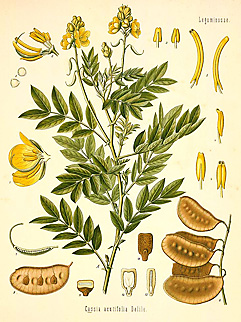Sunny Senna
By Audrey Stallsmith

O a' the ills that come to swall a wearit mither's grief,
The warst is when her laddie winna tak' his senna leaf;
"The Bowl O' Senna Leaf" --Alexander Anderson
As indicated by the poem above the sunny-flowered senna shrub has been hated by generations of laddies—and lassies! In Louisa May Alcott’s Little Women, Mrs. March “left her children to learn alone the lessons which she would gladly have made easier, if they had not objected to taking advice as much as they did salts and senna.”
It’s no wonder they objected to the latter, since its taste is described by Michael Castleman in The Healing Herbs as “nauseating,” and he warns that it also can cause severe cramping. So why do people swallow senna to this day?
We can learn the answer from Shakespeare. In Macbeth, the main character asks “What rhubarb, senna, or what purgative drug,/ Would scour these English hence?” Yes, senna long has been considered one of the most reliable laxatives, since it contains chemicals that “stimulate the colon.” It still appears in over-the-counter medications which treat constipation.
One of D. H. Lawrence’s characters even jokes about it in “Glad Ghosts.” When asked whether a memorial service was moving, he responds, “Rhubarb, senna, that kind of moving!”
The plants employed for such purposes generally are the African or Indian types, Cassia acutifolia (“with pointed leaves”) and angustifolia (“having narrow leaves”) respectively. But we in the U. S. do have a couple native species as well: Cassia herbecarpa (“herbaceous”) and Cassia marilandica (“of Maryland”). Their laxative action reportedly is milder than the foreign varieties, which probably is a good thing!
I received a few seeds of marilandica in a recent trade, having requested them because I see that senna plays host to Sleepy Orange, Orange-barred Sulfur, Cloudless Sulfur, and Silver-spotted Skipper butterflies, as well as to Black Witch and Common Tan Wave moths. Its seeds also help sustain wild turkeys during the winter. So yes, you can grow senna solely for its ferny foliage and clusters of yellow 3/4-inch flowers which appear in mid to late summer—and for the aid it gives to our flying friends.
In fact, I would recommend that you raise it for those reasons rather than trying to medicate yourself with the plant. Too much of it could give you a whopper of a stomach ache, as well as nausea and diarrhea. Castleman recommends that it “should be considered a last resort for constipation,” and warns that pregnant or nursing mothers or persons with chronic stomach problems should avoid taking it.
But any of us can enjoy senna’s flowers, which resemble yellow butterflies themselves, and the flutter-bys which flock to them. And, if you must have a laxative, rhubarb pie tastes much better!
The Cassia acutifolia image is from Kohler's Medizinal Pflanzen, courtesy of plantillustrations.org.








